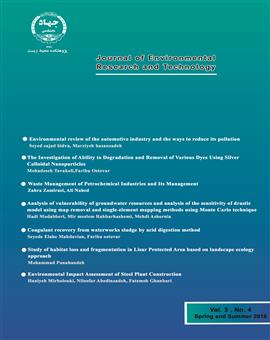Waste Management of Petrochemical Industries and Its Management
Subject Areas : Waste management and technology
1 - عضو هیات علمی
2 -
Keywords: Petrochemical Industries waste management organic wastes heavy metals,
Abstract :
Natural gas and crude distillates such as naphtha from petroleum refining are used as feedstocks to manufacture a wide range of petrochemicals that are in turn used in the manufacture of consumer goods. Petrochemical plants are typically large and complex, and the combination and sequence of products manufactured are often unique to the plant. Petrochemical plants generate significant amounts of solid wastes and sludges, some of which are hazardous because of the presence of toxic organics and heavy metals. A good practice target for a petrochemical complex is to reduce total organic emissions (including VOCs) from the process units to 0.6% of the throughput. In this paper a variety of control of air emissions techniques is has been studied. Petrochemical waste waters often require a combination of treatment methods to remove oil and other contaminants before discharge. For solid and hazardous wastes, combustion (preceded in some cases by solvent extraction) of toxic organics is considered an effective treatment technology for petrochemical organic wastes. Steam stripping and oxidation are also used for treating organic waste streams. The generation of sludges should be minimized. Wastes containing toxic metals should be stabilized before disposal.
1. Robinson, P. R., 2006. “Petroleum processing overview. In Practical Advances in Petroleum Processing”. Springer New York.
2. Akcil, A., Vegliò, F., Ferella, F., Okudan, M.D. and Tuncuk, A., 2015. A review of metal recovery from spent petroleum catalysts and ash. Waste management, 45, pp.420-433..
3. Parkash, S., 2003. “Refining processes handbook”. Gulf Professional Publishing.
4. Younis, S.A., El-Gendy, N.S., El-Azab, W.I., Moustafa, Y.M. and Hashem, A.I., 2014. The biosorption of phenol from petroleum refinery wastewater using spent waste biomass. Energy Sources, Part A: Recovery, Utilization, and Environmental Effects, 36(23), pp.2566-2578.
5. Jasmine, J. and Mukherji, S., 2015. Characterization of oily sludge from a refinery and biodegradability assessment using various hydrocarbon degrading strains and reconstituted consortia. Journal of environmental management, 149, pp.118-125.
6. Cheremisinoff, N. P., 2003. “Handbook of solid waste management and waste minimization technologies”. Butterworth-Heinemann.
7. Kincaid, L.E., 1997. “Cleaner Technologies Substitutes Assessment: a methodology & resource guide”. US Environmental Protection Agency, Office of Pollution Prevention and Toxics.
8. Li, J.P., Yang, X.J., Ma, L., Yang, Q., Zhang, Y.H., Bai, Z.S., Fang, X.C., Li, L.Q., Gao, Y. and Wang, H.L., 2016. The enhancement on the waste management of spent hydrotreating catalysts for residue oil by a hydrothermal–hydrocyclone process. Catalysis Today, 271, pp.163-171.
9. Shie, J.L., Lin, J.P., Chang, C.Y., Wu, C.H., Lee, D.J., Chang, C.F. and Chen, Y.H., 2004. “Oxidative thermal treatment of oil sludge at low heating rates”. Energy & fuels, 18(5), pp.1272-1281.
10. Greenberg, M.R., 2017. Hazardous waste sites: The credibility gap. Routledge.


